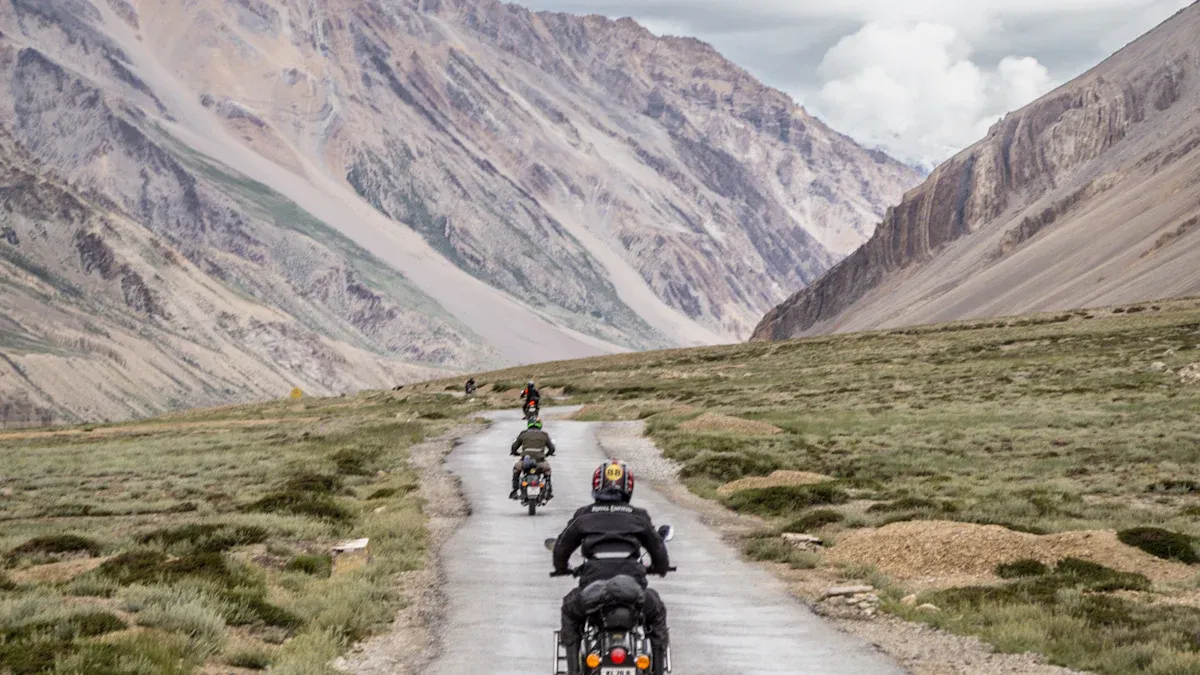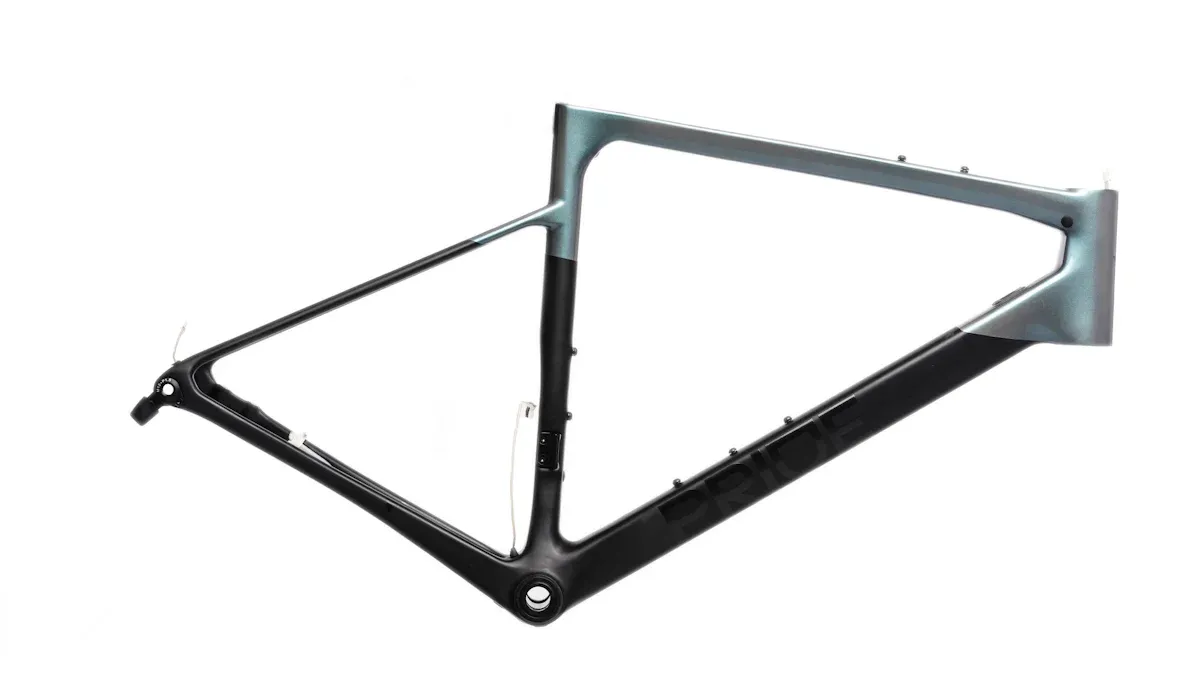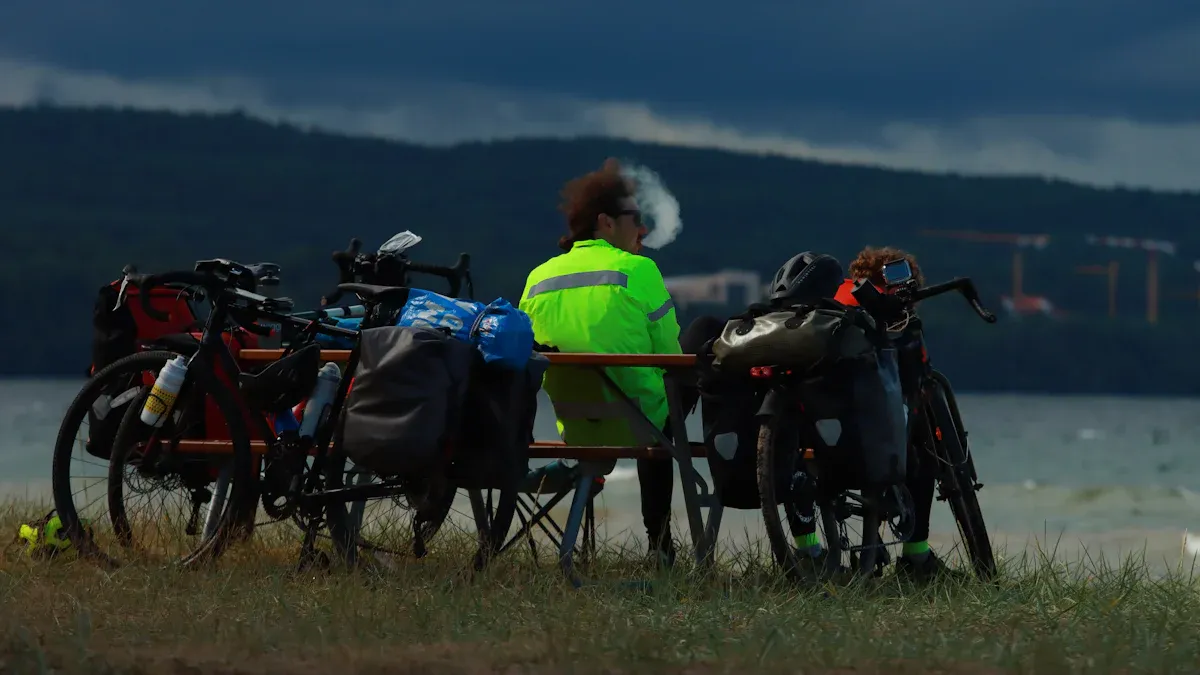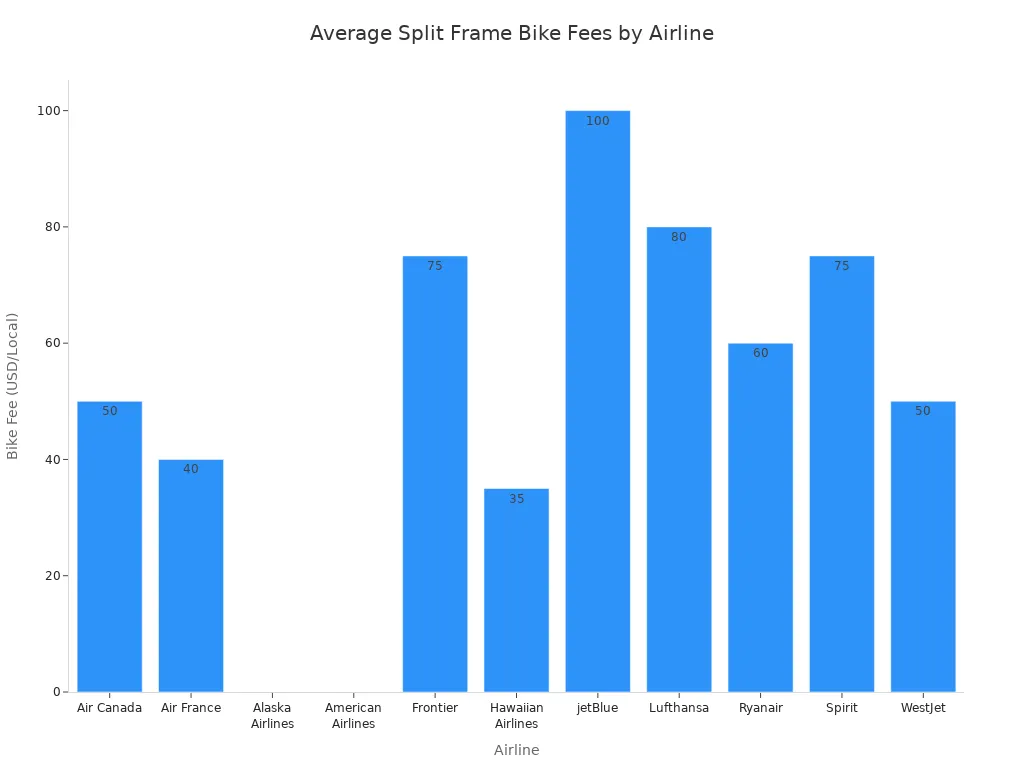
Traveling with a split frame bike can be easy if you get ready. First, think about how to pack your bike. Also, consider the best ways to transport it. Taking your bike apart makes it easier to handle. Using the right packing materials keeps it safe during travel. Whether you fly, take a train, or drive, knowing how to move your split frame bike will make your trip better and more fun.
Key Takeaways
Take apart your split frame bike before you travel. This makes it easier to pack and helps stop damage.
Use good packing materials like foam and bubble wrap. These keep your bike safe from scratches and dents while moving.
Look at airline rules for bike fees before you book. Different airlines have different rules, so be ready to avoid surprises.
Make sure your bike is secure when traveling by car. Use a bike rack and lock it to stop theft or damage.
Do a bike check before you travel. Make sure tires, brakes, and the chain are working well for a safe ride.
Packing Your Split Frame Bike

Disassembling the Bike
When you’re ready to travel with your split frame bike, disassembling it is a crucial first step. This process not only makes your bike easier to pack but also helps prevent damage during transit. Here’s how you can do it effectively:
Remove the front wheel and, if necessary, the rear wheel.
Take off the stem and hang the handlebars along the frame. This keeps them from hanging over the brake and gear cables.
Lower the saddle to save space.
Use a component tray to organize small parts and label them for easy reassembly later.
Take photos of each step to assist with putting everything back together when you arrive at your destination.
For tools, you’ll need a few essentials:
A set of hex wrenches (3, 4, 5, 6, and 8 mm)
A torque wrench
A pair of pliers
If you’re removing crank arms, use a crank-puller tool and apply force carefully. Having a second person to help can make the disassembly process smoother and safer.
Packing Materials
Choosing the right packing materials is just as important as disassembling your bike. Proper protection can significantly reduce the risk of damage during travel. Here are some materials you should consider:
Frame Protection Tapes: These are essential for safeguarding your bike frame. Options like ISC Racer’s Tape or Lizard Skins Protective Frame Kit work well.
Foam Padding: Wrapping your bike frame and components with foam prevents scratches and structural damage. You can use foam tubing to wrap each frame tube and secure it with zip ties.
Bubble Wrap: This is great for extra cushioning around delicate parts.
Cardboard Boxes: If you have a specific bike box, that’s ideal. If not, a sturdy cardboard box can work in a pinch.
Using these materials effectively can help eliminate common issues like scratches, dings, and dents caused by components rubbing against the frame. Remember, the goal is to keep your split frame bike safe and sound during your travels!
Transportation Options for Split Frame Bikes

Traveling with your split frame bike can be easy if you know the best ways to transport it. Let’s look at how to travel by air, train, and car.
Air Travel Considerations
For airline travel, check the rules of the airline you pick. Different airlines have different fees and rules for bikes. Here’s a quick look at some major airlines and their bike fees:
Airline | Bike Fee | 1st Checked Bag Fee | Oversize Fee | Overweight Fee |
|---|---|---|---|---|
Air Canada | $50 CAD/USD | N/A | N/A | N/A |
Air France | €40-€125 | Usually included | N/A | N/A |
Alaska Airlines | No Fee | $30 | N/A for bikes | N/A for bikes |
American Airlines | No Fee | $30 | $150 – $200 | $100 |
British Airways | No Fee | Usually included | Uncertain | €75/$100 USD |
Delta | No Fee | $30 | $200 | $100 |
Frontier | $75 | N/A | N/A | N/A |
Hawaiian Airlines | $35 – $150 | $0–$35 | N/A | $60-$150 |
jetBlue | $100 if large/heavy | $35 | N/A | N/A |
Lufthansa | $80-$287 if oversized | Usually included | $150-$300 | $70-$150 |
Southwest | No Fee | Usually Included | $75 | $75 |

Before you book, always check the latest rules on the airline’s website. Some airlines may want you to pack your bike a certain way. Follow their rules to avoid surprises at the airport.
Train Travel Tips
If you like train travel, know the rules for bringing your split frame bike. Here are some important points:
High-speed trains usually do not carry bikes, but local trains often do.
Always ask at the ticket window if the train allows bikes and buy a bike ticket, which is not part of the Eurail Pass.
Bikes must go in special bike areas on the train.
By planning ahead, you can have a smooth trip with your bike on the train.
Traveling by Car
When traveling by car, it’s important to secure your split frame bike well. Here are some tips to follow:
Lock the bike rack to the car and the bikes to the rack to reduce the chance of losing them.
Check your insurance policy for details about loss or damage during transport.
Think about using a bike case laid down sideways or mailing the bike if you can use tools.
Use a cable lock to secure the bike, especially on mountain roads where it might fall off the rack.
Don’t put the bike on the roof to avoid forgetting it in low-clearance areas like drive-thrus.
Choose a hitch rack for better fuel economy and ease of use, while lowering the risk of damage from low-clearance spots.
By following these tips, you can travel confidently with your split frame bike, no matter how you choose to get there!
Maintenance for Your Split Frame Bike During Travel
Pre-Travel Bike Check
Before you start your trip with your split frame bike, check it carefully. This helps make sure your bike is ready for the journey. Here’s what to look at:
Tire Issues: Make sure tires are properly inflated. Look for cracks or wear that could cause a flat.
Brake Functionality: Check that your brakes work well. You need to stop safely when needed.
Chain Condition: Look at your chain for dirt and lubrication. A clean chain helps with smooth shifting.
Frame Integrity: Check for cracks in the frame and see if the headset is loose. A strong frame is important for safety.
Wheel Trueness: Ensure your rims are straight and not wobbling. This keeps you stable while riding.
Also, think about the tools you need for disassembly. Practice taking your bike apart before your trip. Keep your tools organized and ready. Here’s a quick list of tools to pack:
A multi-tool for removing pedals, seatpost, rear derailleur, and handlebars.
A list of tools you need, packed separately for easy access.
Consider lighter tools if you don’t need a full workshop.
On-the-Road Maintenance Tips
While traveling, keeping your split frame bike in good shape is important for a fun trip. Here are some helpful maintenance tips to follow:
Pedal Removal/Refitting: This is important before and after flying with your bike.
Drivetrain Maintenance: Regularly lubricate your chain and check gear shifting for smoothness.
Cockpit Tweaks: Adjust saddle tilt and cleat position for better comfort.
Puncture Repairs: Be ready for flat tires. Carry a spare tube and patch kit for emergencies.
Brake Adjustments: Regularly check and replace brake shoes for good braking.
Cable Renewals: Keep spare brake and shifter cables for reliable shifting and braking.
Tyre Repairs: Fix any sidewall splits or blowouts quickly.
Bearing Overhaul: Regularly check pedals, wheel hubs, bottom brackets, and headsets for smooth use.
Drivetrain Component Replacement: Be ready to change worn-out parts like chains and cassettes.
Wheel Maintenance: Watch for wheel integrity. Truing and rebuilding may be needed on long trips.
Remember to clean your bike often to keep it working well. Check for wear and tear, and tighten all bolts to keep everything secure. By following these maintenance tips, you’ll keep your split frame bike in great shape during your travels!
Safety Precautions for Split Frame Bikes
Securing Your Bike
When you travel with your split frame bike, it’s very important to keep it safe from theft and damage. Here are some good ways to protect your bike:
Use High-Quality Locks: U-locks are some of the best locks for your bike. Look for models like the Litelok X1, which can resist angle grinder attacks. Other strong options are the OnGuard Brute and ABUS Granit XPlus 540.
Swap Quick-Release Skewers: Change quick-release wheel skewers to ones that need tools to take off. This small change can help stop thieves.
Park in Visible Areas: Always pick bright spots, especially under security cameras. Being visible can scare off possible thieves.
Keep Valuables Close: Take off bags with valuables and carry them with you. If you have to leave them on the bike, make sure they’re hard to reach.
Ask for Help: When you go to cafes or restaurants, ask the staff if there’s a safe place to leave your bike. Some places might have special bike parking.
By following these tips, you can feel safe while exploring new places.
Insurance and Coverage
Insurance can give you extra protection for your split frame bike when you travel. Here’s a quick look at what you might think about:
Type of Bike Insurance | |
|---|---|
Comprehensive Bicycle Coverage | $16.99 |
Road Bike Insurance | $16.99 |
eBike Insurance | $16.99 |
Triathlon Bike Insurance | $16.99 |
Mountain Bike Insurance | $16.99 |
Gravel Bike Insurance | $16.99 |
Fat Bike Insurance | $16.99 |
Cyclocross Bike Insurance | $16.99 |
Cargo Bike Insurance | $16.99 |
Adaptive Para Bike Insurance | $16.99 |
Your Bicycle Insurance | $16.99 |
Make sure your policy covers theft outside your home. Renters or homeowners insurance might also cover theft costs, so check your policy details.
By taking these precautions and thinking about insurance, you can travel with confidence with your split frame bike, knowing you’ve done your best to keep it safe.
Traveling with your split frame bike can be easy if you use good tips. Taking your bike apart, using the right packing materials, and knowing how to transport it really help. Many people say packing bikes, like the Ritchey Steel Cross Frame, is simple and keeps them working well. By doing these things, you can enjoy your ride without stress about damage or problems. So, get ready and hit the road with confidence!
FAQ
How do I know if my split frame bike fits in a travel case?
Look at the size of your bike. Then, compare it to the travel case sizes. Most cases show which bike sizes fit. If you are not sure, ask the maker or seller for help.
Can I take my split frame bike on public transport?
Yes, you can take your split frame bike on public transport. But the rules can be different depending on where you are. Always check the rules for trains, buses, or subways in your area before you travel.
What tools should I bring for bike maintenance on the road?
Bring a multi-tool, tire levers, a spare tube, and a pump. These tools help you fix common problems like flat tires and make small changes while you travel.
How can I prevent my bike from getting stolen during travel?
Use strong locks and park in bright, visible places. Think about using a lock for quick-release parts. Always keep your valuables close and ask for safe parking options when you can.
Is bike insurance worth it for travel?
Yes, bike insurance can help you feel safe while you travel. It covers theft and damage, so you are protected. Check your policy details to see what is included and think about getting more coverage if you need it.
See Also
Key Considerations for Selecting a Durable Cargo Bike Frame
Effective Strategies to Safeguard Your Bicycle Frame
Exploring the Benefits of Step-Through Frame Bicycles
